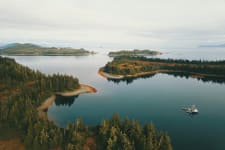Ever since the disastrous meltdown of Japan’s Fukushima reactor in 2011, scientists have been monitoring the effect of radiation on Japan’s environment, where the incident occurred, and also to trace radiation in fish all across the Pacific Ocean.
As of August 2023, Japan began releasing treated water used to cool the nuclear reactors at Fukushima back into the ocean. Extensive testing sponsored by international governments and organizations has found that this treated wastewater is safe and poses no threat to drinking water or food.
Here’s everything you need to know about the science and safety of Pacific seafood, following the Fukushima disaster.
Safety of Treated Wastewater from Fukushima
The wastewater being released from Fukushima poses no threat to food or drinking water. The water has been heavily filtered by the Advanced Liquid Processing System to remove all but trace amounts of a hydrogen molecule called tritium, which is only harmful when consumed in "exceptionally large doses." The wastewater being released contains a level of tritium that is comparable to natural background levels of radioactivity that can already be found in the ocean.
In fact, the concentration of tritium in the release water will be less than one seventh of the WHO level acceptable for drinking water, so the water is safe for consumption in food and drinking water according to a statement from Alaska Seafood Marketing Institute Technical Director John Burrows. “The Pacific Ocean’s ability to quickly dilute radioactive materials to acceptable drinking water levels within miles of Fukushima has been demonstrated by numerous studies,” explained Burrows.
The Current State of Seafood Safety After Fukushima
Prior to the release of treated wastewater in 2023, experts had determined that seafood from Alaska was free of radiation following the Fukushima disaster. Testing over the years by Alaskan agencies in partnership with the federal government, as well as international governments and organizations (including the International Atomic Energy Agency), has confirmed this to date.
Ever since 2014, the Alaska Department of Environmental Conservation (ADEC) has been testing for radiation on an annual basis and has not found any traces of Fukushima-related radionuclides Iodine-131, Cesium-134 or Cesium-137 in samples of Alaskan salmon. In fact, through April 2023, no detectable levels of radiation have been found in Alaska fish.
“The Fukushima leaks [in 2011] were miniscule compared to the vast scale of the Pacific," said Nicholas S. Fisher, an expert on nuclear radiation in marine animals at Stony Brook University in New York, in an article published by Oceana, a non-profit dedicated to protecting and restoring the world’s oceans. “The disaster added just a fraction of a percent to the radiation that’s already in the ocean, 99 percent of which is naturally occurring. At those levels, you could eat piles of Pacific fish and have nothing to worry about from radiation," Fisher said.
For a comprehensive look at all matters and studies related to Fukushima radiation concerns in Alaskan seafood, we encourage you to visit the ADEC homepage on radiation in Alaskan fisheries.
Additional sources:
Alaska Dept of Health and Social Services – Radiation FAQ
IAEA's Comprehensive Report on the Safety of Treated Wastewater Release from Fukushima






